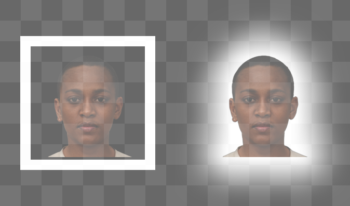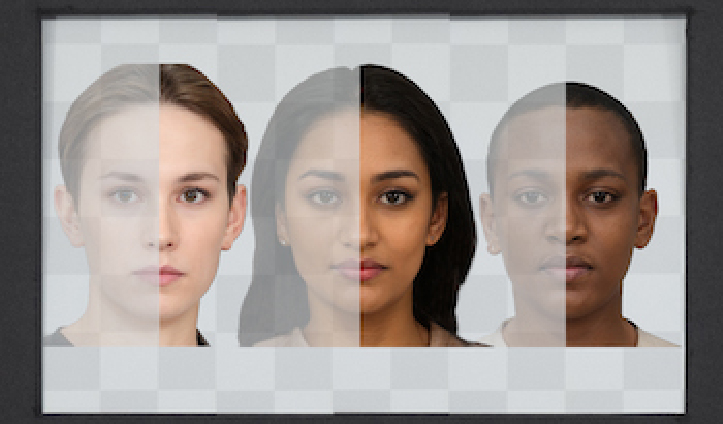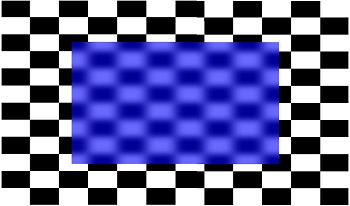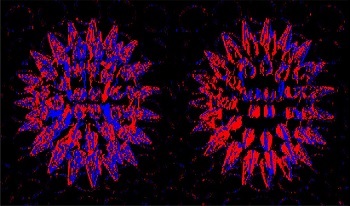
Ubiquitous throughout the history of photography, white borders on photo prints and vintage Polaroids remain useful as new technologies including augmented reality emerge for general use. In contemporary optical see-through augmented reality (OST-AR) displays, physical transparency limits the visibility of dark stimuli. However, recent research shows that simple image manipulations, white borders and outer glows, have a strong visual effect, making dark objects appear darker and more opaque. In this work, the practical value of known, inter-related effects including lightness induction, glare illusion, Cornsweet illusion, and simultaneous contrast are explored. The results show promising improvements to visibility and visual quality in future OST-AR interfaces.

Augmented reality (AR) combines elements of the real world with additional virtual content, creating a blended viewing environment. Optical see-through AR (OST-AR) accomplishes this by using a transparent beam splitter to overlay virtual elements over a user’s view of the real world. However, the inherent see-through nature of OST-AR carries challenges for color appearance, especially around the appearance of darker and less chromatic objects. When displaying human faces—a promising application of AR technology—these challenges disproportionately affect darker skin tones, making them appear more transparent than lighter skin tones. Still, some transparency in the rendered object may not be entirely negative; people’s evaluations of transparency when interacting with other humans in AR-mediated modalities are not yet fully understood. In this work, two psychophysical experiments were conducted to assess how people evaluate OST-AR transparency across several characteristics including different skin tones, object types, lighting conditions, and display types. The results provide a scale of perceived transparency allowing comparisons to transparency for conventional emissive displays. The results also demonstrate how AR transparency impacts perceptions of object preference and fit within the environment. These results reveal several areas with need for further attention, particularly regarding darker skin tones, lighter ambient lighting, and displaying human faces more generally. This work may be useful in guiding the development of OST-AR technology, and emphasizes the importance of AR design goals, perception of human faces, and optimizing visual appearance in extended reality systems.

Augmented reality (AR) combines elements of the real world with additional virtual content, creating a blended viewing environment. Optical see-through AR (OST-AR) accomplishes this by using a transparent beam splitter to overlay virtual elements over a user’s view of the real world. However, the inherent see-through nature of OST-AR carries challenges for color appearance, especially around the appearance of darker and less chromatic objects. When displaying human faces—a promising application of AR technology—these challenges disproportionately affect darker skin tones, making them appear more transparent than lighter skin tones. Still, some transparency in the rendered object may not be entirely negative; people’s evaluations of transparency when interacting with other humans in AR-mediated modalities are not yet fully understood. In this work, two psychophysical experiments were conducted to assess how people evaluate OST-AR transparency across several characteristics including different skin tones, object types, lighting conditions, and display types. The results provide a scale of perceived transparency allowing comparisons to transparency for conventional emissive displays. The results also demonstrate how AR transparency impacts perceptions of object preference and fit within the environment. These results reveal several areas with need for further attention, particularly regarding darker skin tones, lighter ambient lighting, and displaying human faces more generally. This work may be useful in guiding the development of OST-AR technology, and emphasizes the importance of AR design goals, perception of human faces, and optimizing visual appearance in extended reality systems.

Translucency is an appearance attribute, which primarily results from subsurface scattering of light. The visual perception of translucency has gained attention in the past two decades. However, the studies mostly address thick and complex 3D objects that completely occlude the background. On the other hand, the perception of transparency of flat and thin see-through filters has been studied more extensively. Despite this, perception of translucency in see-through filters that do not completely occlude the background remains understudied. In this work, we manipulated the sharpness and contrast of black-and-white checkerboard patterns to simulate the impression of see-through filters. Afterward, we conducted paired-comparison psychophysical experiments to measure how the amount of background blur and contrast relates to perceived translucency. We found that while both blur and contrast affect translucency, the relationship is neither monotonic, nor straightforward.

The visual mechanisms behind our ability to distinguish translucent and opaque materials is not fully understood. Disentanglement of the contributions of surface reflectance and subsurface light transport to the still image structure is an ill-posed problem. While the overwhelming majority of the works addressing translucency perception use static stimuli, behavioral studies show that human observers tend to move objects to assess their translucency. Therefore, we hypothesize that translucent objects appear more translucent and less opaque when observed in motion than when shown as still images. In this manuscript, we report two psychophysical experiments that we conducted using static and dynamic visual stimuli to investigate how motion affects perceived translucency.